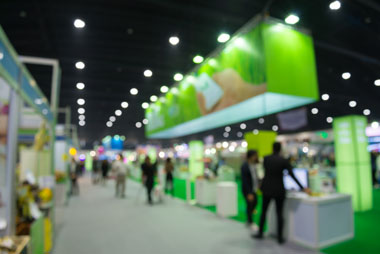
At Imbue, we’ve designed spectacular trade show exhibits for clients—but exhibit design is just a small part of what goes into successful participation at a trade show. In order to achieve your trade show goals you must have a well-planned strategy. Simply setting up a fabulous looking booth staffed with warm bodies wearing name tags does not guarantee success. There are many ways to attract viable prospects to your booth, but the work begins long before you hit the trade show floor!
Trade shows can be leveraged to introduce a new product or service, broadcast incentives to sell more of your product, create brand awareness, and to meet with current customers in person. The planning should begin up to six months in advance of the event especially for things like booth design, advertising your attendance in a trade journal, having direct mail pieces created, planning special presentations, and hosting events.
These five tips will help create a successful trade show experience:
- Know Your Objectives
Figure out exactly what you want to achieve at this event and be very specific about setting goals. For example:
- Identify who your target audience is and then focus on what you want to communicate to them. It’s imperative to clearly define the ways your company can enhance their businesses/lives.
- Calculate the number of attendees you hope to convert into strong leads or sales. You can do this by taking the number expected, cutting that amount in half, and assuming 16–20% of that number are viable prospects. (Trade Show News Network has attendance numbers for specific shows as well as information for identifying shows to attend.)
- Plan Your Exhibit Booth Well
If you don’t already have a trade show display or booth, talk to a trusted partner about what will best suit the needs of your business and get that ball rolling. If you do have a booth, update or refresh panels as needed to target your message for the specific show.
A well-designed exhibit booth will entice attendees who are walking by as well as impress those who seek you out based on the dynamic, pre-show marketing you did! Your display should be open and inviting, not too cluttered, and tease prospects to investigate further rather than attempting to convey absolutely everything about your company.
Another consideration is location within the exhibition hall. If you have a choice, ask to be at least one aisle back from the front, somewhere in the center of the hall (or the right side over left, if off center), and ideally away from columns. Strategies for making your booth stand out if placed along the perimeter are to go tall with your booth, or employ signs that hang from the ceiling above your display.
- Be Smart with Your Pre-Show Marketing
Starting three weeks before the event, use direct mail, email, and social media to spark interest in your company. Make sure your best prospects know you’ll be there, and make it easy for them to remember to look for you on the trade show floor. Presentations, demonstrations, giveaways, and product unveilings are great ways to incentivize prospects to show up at your booth. Be sure to promote these events in your pre-show marketing campaigns.
- Choose the Right Staff
A well-trained sales force is a crucial component to success in meeting your goals. And deploying enough staff to handle the volume of visitors is key as well.
An effective booth staffer will:
- Understand the process of engaging, qualifying, communicating, and closing
- Be approachable, inviting, and great at starting a dialogue with visitors
- Speak comfortably and knowledgably about the company, organization, or product
- Act professionally and strive to understand the visitor’s needs
Here is a reference guide on staff training from Skyline.
- Think About Post-Show Follow-up—During the Trade Show
Typically, a large number of leads are never pursued after an event because not enough solid information was gathered on visitors. This goes back to training booth staffers to quickly gauge the viability of a prospect and collect information from them in order to follow-up afterwards.
The follow-up should include sending personal messages and relevant materials to potential customers. Planning a follow-up campaign that has multiple touch points is critical to success. Printed materials should be prepared and ready to be mailed to prospects promptly after the event.
Final Thoughts
As you can see, a lot of goal setting, planning, and training goes into achieving great results. Decide how much Return on Investment (ROI) will make the show worth it for you. Since trade shows can be used to accomplish a multitude of goals including brand exposure, PR, and networking, it’s crucial to identify and plan your strategies well in advance. And then follow-up, follow-up, follow-up!


Comments